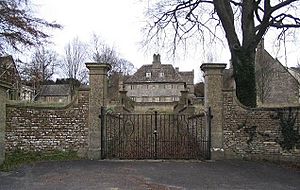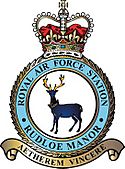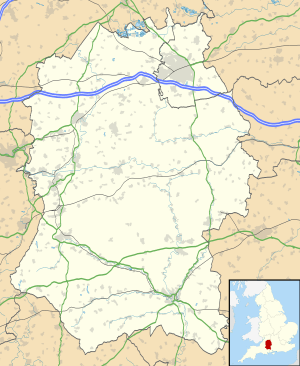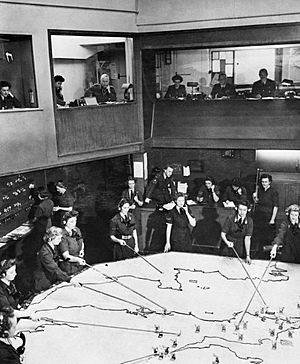RAF Rudloe Manor facts for kids
Quick facts for kids RAF Rudloe Manor
|
|
|---|---|
| Corsham, Wiltshire, England | |

Rudloe Manor main house
|
|
 |
|
|
Shown within Wiltshire
|
|
| Coordinates | 51°25′14.28″N 2°13′0.70″W / 51.4206333°N 2.2168611°W |
| Site information | |
| Owner | Private, Military |
| Open to the public |
No |
| Condition | Standing |
| Site history | |
| In use | 1939–2000 |
| Battles/wars | Second World War |
| Garrison information | |
| Occupants | No. 10 Group RAF |
RAF Rudloe Manor, also known as RAF Box, was a base for the Royal Air Force (RAF). It was located near Bath, England, between the towns of Box and Corsham in Wiltshire. This base was one of several military sites in the area. It covered three separate locations. Today, some parts are used by Defence Digital, some are empty, and some have been sold, including the main Rudloe Manor house.
Contents
Rudloe Manor During World War II
The RAF base was built on top of old quarries. These quarries were where Bath stone was dug out. In the 1930s, some of the tunnels were turned into a huge storage area for ammunition. This place was called the Central Ammunition Depot. The giant underground spaces had about 2.25 million square feet (209,000 square meters) of room. This huge area was divided into many smaller sections.
During the Second World War, the main control center for No. 10 Group RAF was located here. This center had three important buildings: an Operations Room, a Filter Room, and a Communications Centre. These buildings were partly buried underground to keep them safe from attacks. Other RAF groups had similar protected buildings in different parts of the UK.
The Operations Room
The Operations Room was very important. Its job was to guide RAF planes in the area covered by No. 10 Group. This area included South West England and South Wales. The room first opened in June 1940, next to the main manor house. Later that year, it moved into the north end of a secret underground bunker in Browns Quarry. The Operations Room stopped being used in May 1945 when No. 10 Group was no longer needed.
The Filter Room
The Filter Room was also in the underground bunker in Browns Quarry. It started working in 1940. Its job was to sort through a lot of information about enemy planes and activities. This filtered information was then sent to the Operations Room. Like the Operations Room, the Filter Room closed in May 1945. A woman named Eileen Younghusband worked in Filter Rooms. She wrote about her experiences at Rudloe Manor in her book, One Woman's War.
The Communications Centre was in the west part of the same underground bunker. Women from the Women's Auxiliary Air Force (WAAF) worked in this bunker. They lived nearby at a place called Hartham Park.
RAF Units at Rudloe Manor
Many different RAF units used the Rudloe Manor site over the years:
| Unit | Years Used | What They Did |
|---|---|---|
| No. 10 (Fighter) Group RAF | 1940–1945 | Protected places like Plymouth and other ports in the southwest. They also guarded naval bases and ships. |
| Fighter Command Control and Reporting School RAF | 1945–1948 | Taught people how to control and report on fighter planes. |
| Headquarters Southern Sector RAF | 1950–1957 | The main office for the southern part of the RAF's defense system. |
| No. 81 (Training) Group RAF | 1952–1958 | A training group for Fighter Command. |
| No. 24 (Training) Group RAF | 1958–1973 | Part of the RAF's training command. They oversaw all schools that taught technical skills. |
After the War: Britain's Area 51?
RAF Rudloe Manor is sometimes called "Britain's Area 51". This is because secret government files, which are now public, showed that the base was a center for UFO investigations in the 1950s.
The wider base continued to be important for communications and various administrative tasks. No.1 Signals Unit was created to manage all the RAF's land-based communication systems in the UK. In the late 1960s, when the UK launched its Skynet satellite system, a new control center was set up at Rudloe Manor. This center managed defense communications. A special operations center for spacecraft was also built on a small part of the base called Hawthorn.
The main office for the RAF Provost and Security Service was also located nearby. However, when the base closed, this office moved to RAF Henlow.
From 1952 to 1980, Rudloe Manor was also home to the headquarters of the Southern Area Royal Observer Corps (ROC). The ROC's job was to watch for enemy aircraft. Also located here was the Southern Sector headquarters of the United Kingdom Warning and Monitoring Organisation. This group was responsible for the "four-minute warning" system during the Cold War. This system would have warned people about a nuclear attack.
The base was next to other military sites. These included Basil Hill Barracks, HMS Royal Arthur, and the Royal Naval Stores Depot (RNSD) Copenacre.
Closure of the Base
The RAF station at Rudloe Manor closed down in the year 2000. The Defence Communication Services Agency (DCSA) then took over the sites. Later, in 2008, this agency was reorganized into the Information Systems & Services group.
The Manor House
The main house, known as Rudloe Manor, is next to the northern part of the base. It is north of the A4 road. The house dates back to the 13th century and was rebuilt around 1685. In 1985, it was given a special historic status as a Grade II* listed building. A 12th-century barn and a 17th-century entrance, both also historic, are nearby.
In 2021, Rudloe Manor was sold to a private owner. Work has been done to restore the old house.
See Also
- Corsham Computer Centre
- MoD Corsham



